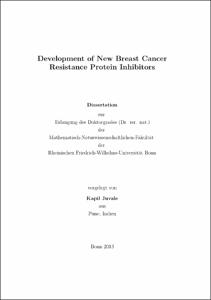Juvale, Kapil: Development of New Breast Cancer Resistance Protein Inhibitors. - Bonn, 2013. - Dissertation, Rheinische Friedrich-Wilhelms-Universität Bonn.
Online-Ausgabe in bonndoc: https://nbn-resolving.org/urn:nbn:de:hbz:5n-32665
Online-Ausgabe in bonndoc: https://nbn-resolving.org/urn:nbn:de:hbz:5n-32665
@phdthesis{handle:20.500.11811/5711,
urn: https://nbn-resolving.org/urn:nbn:de:hbz:5n-32665,
author = {{Kapil Juvale}},
title = {Development of New Breast Cancer Resistance Protein Inhibitors},
school = {Rheinische Friedrich-Wilhelms-Universität Bonn},
year = 2013,
month = jul,
note = {Chemotherapy is a major form of treatment for cancers. Unfortunately, the majority of cancers are either resistant to chemotherapy or acquire resistance (MDR) during treatment. The most common mechanism by which human cancers develop multidrug resistance is overexpression of certain ATP-binding cassette (ABC) transporters. Breast Cancer Resistance Protein (BCRP / ABCG2), a member of ATP binding cassette family ABCG has been found to confer multidrug resistance in cancer cells. One of the strategies to overcome resistance due to BCRP overexpression is the investigation of potent and specific BCRP inhibitors. Several inhibitors of BCRP have been developed in last decade in an attempt to overcome the resistance mediated by this transporter, but there are only very few potent and selective BCRP inhibitors such as Ko143. Aim of the current project was to develop new potent and selective BCRP inhibitors. In this work a total of 131 compounds spanning different chemical classes such as chalcone, flavonoid and quinazoline were investigated. Several biological studies were carried out using these compounds to determine their BCRP inhibitory potential, selectivity, toxicity and efficacy to reverse MDR to certain anticancer compounds. The study of all three classes of compounds revealed structural requirements for BCRP inhibition. In this study, chalcones and benzoflavones showed moderate to good BCRP inhibition with selectivity towards BCRP over other transporters. Amongst chalcones and flavones, 7,8-benzoflavones were the most potent BCRP inhibitors. The structural activity relationship of quinazoline compounds revealed the importance of a 2-phenyl substitution in quinazoline scaffold for BCRP inhibition. The quinazoline compounds were the most active compounds among all classes, some of the quinazolines showing even better activity than Ko143. The results obtained from the study of chalcones, flavonoids and quinazolines as BCRP inhibitors are promising for the ongoing research to find potent BCRP inhibitors.},
url = {https://hdl.handle.net/20.500.11811/5711}
}
urn: https://nbn-resolving.org/urn:nbn:de:hbz:5n-32665,
author = {{Kapil Juvale}},
title = {Development of New Breast Cancer Resistance Protein Inhibitors},
school = {Rheinische Friedrich-Wilhelms-Universität Bonn},
year = 2013,
month = jul,
note = {Chemotherapy is a major form of treatment for cancers. Unfortunately, the majority of cancers are either resistant to chemotherapy or acquire resistance (MDR) during treatment. The most common mechanism by which human cancers develop multidrug resistance is overexpression of certain ATP-binding cassette (ABC) transporters. Breast Cancer Resistance Protein (BCRP / ABCG2), a member of ATP binding cassette family ABCG has been found to confer multidrug resistance in cancer cells. One of the strategies to overcome resistance due to BCRP overexpression is the investigation of potent and specific BCRP inhibitors. Several inhibitors of BCRP have been developed in last decade in an attempt to overcome the resistance mediated by this transporter, but there are only very few potent and selective BCRP inhibitors such as Ko143. Aim of the current project was to develop new potent and selective BCRP inhibitors. In this work a total of 131 compounds spanning different chemical classes such as chalcone, flavonoid and quinazoline were investigated. Several biological studies were carried out using these compounds to determine their BCRP inhibitory potential, selectivity, toxicity and efficacy to reverse MDR to certain anticancer compounds. The study of all three classes of compounds revealed structural requirements for BCRP inhibition. In this study, chalcones and benzoflavones showed moderate to good BCRP inhibition with selectivity towards BCRP over other transporters. Amongst chalcones and flavones, 7,8-benzoflavones were the most potent BCRP inhibitors. The structural activity relationship of quinazoline compounds revealed the importance of a 2-phenyl substitution in quinazoline scaffold for BCRP inhibition. The quinazoline compounds were the most active compounds among all classes, some of the quinazolines showing even better activity than Ko143. The results obtained from the study of chalcones, flavonoids and quinazolines as BCRP inhibitors are promising for the ongoing research to find potent BCRP inhibitors.},
url = {https://hdl.handle.net/20.500.11811/5711}
}






